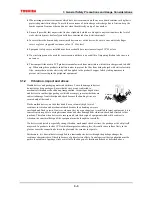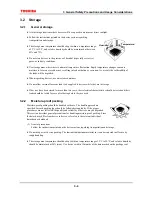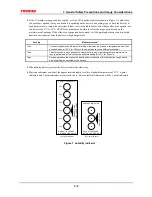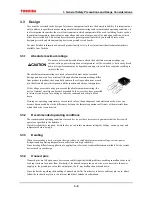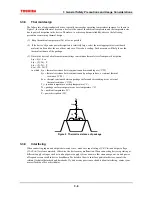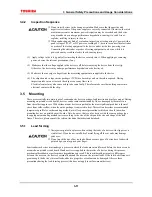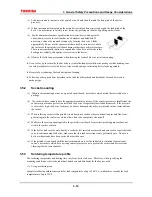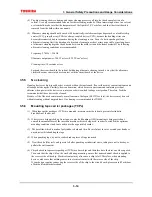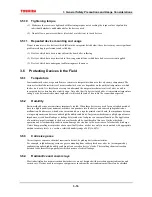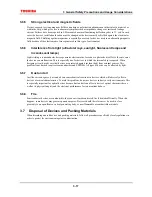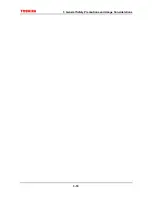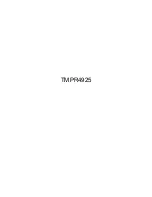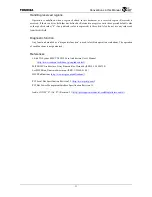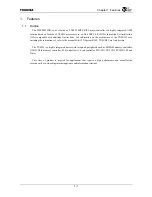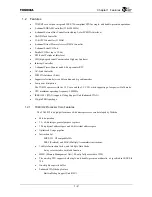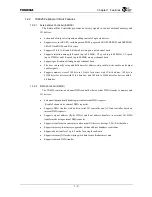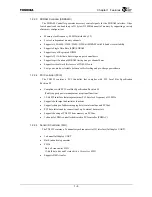
3 General Safety Precautions and Usage Considerations
3-14
(4) The dip cleaning, shower cleaning and steam cleaning processes all involve the chemical action of a
solvent. Use only recommended solvents for these cleaning methods. When immersing devices in a solvent
or steam bath, make sure that the temperature of the liquid is 50°C or below, and that the circuit board is
removed from the bath within one minute.
(5) Ultrasonic cleaning should not be used with hermetically-sealed ceramic packages such as a leadless chip
carrier (LCC), pin grid array (PGA) or charge-coupled device (CCD), because the bonding wires can
become disconnected due to resonance during the cleaning process. Even if a device package allows
ultrasonic cleaning, limit the duration of ultrasonic cleaning to as short a time as possible, since long hours
of ultrasonic cleaning degrade the adhesion between the mold resin and the frame material. The following
ultrasonic cleaning conditions are recommended:
Frequency: 27 kHz
∼
29 kHz
Ultrasonic output power: 300 W or less (0.25
W/cm
2
or less)
Cleaning time: 30 seconds or less
Suspend the circuit board in the solvent bath during ultrasonic cleaning in such a way that the ultrasonic
vibrator does not come into direct contact with the circuit board or the device.
3.5.5 No
cleaning
If analog devices or high-speed devices are used without being cleaned, flux residues may cause minute amounts
of leakage between pins. Similarly, dew condensation, which occurs in environments containing residual
chlorine when power to the device is on, may cause between-lead leakage or migration. Therefore, Toshiba
recommends that these devices be cleaned.
However, if the flux used contains only a small amount of halogen (0.05W% or less), the devices may be used
without cleaning without any problems. No cleaning is recommended for TX4925.
3.5.6
Mounting tape carrier packages (TCPs)
(1) When tape carrier packages (TCPs) are mounted, measures must be taken to prevent electrostatic
breakdown of the devices.
(2) If devices are being picked up from tape, or outer lead bonding (OLB) mounting is being carried out,
consult the manufacturer of the insertion machine which is being used, in order to establish the optimum
mounting conditions in advance and to avoid any possible hazards.
(3) The base film, which is made of polyimide, is hard and thin. Be careful not to cut or scratch your hands or
any objects while handling the tape.
(4) When punching tape, try not to scatter broken pieces of tape too much.
(5) Treat the extra film, reels and spacers left after punching as industrial waste, taking care not to destroy or
pollute the environment.
(6) Chips housed in tape carrier packages (TCPs) are bare chips and therefore have their reverse side exposed.
To ensure that the chip will not be cracked during mounting, ensure that no mechanical shock is applied to
the reverse side of the chip. Electrical contact may also cause a chip to fail. Therefore, when mounting
devices, make sure that nothing comes into electrical contact with the reverse side of the chip.
If your design requires connecting the reverse side of the chip to the circuit board, please consult Toshiba or
a Toshiba distributor beforehand.
Summary of Contents for TMPR4925
Page 1: ...64 Bit TX System RISC TX49 Family TMPR4925 Rev 3 0 ...
Page 4: ......
Page 15: ...Handling Precautions ...
Page 16: ......
Page 18: ...1 Using Toshiba Semiconductors Safely 1 2 ...
Page 40: ...3 General Safety Precautions and Usage Considerations 3 18 ...
Page 42: ...4 Precautions and Usage Considerations 4 2 ...
Page 43: ...TMPR4925 ...
Page 44: ......
Page 54: ...Chapter 1 Features 1 8 ...
Page 58: ...Chapter 2 Block Diagram 2 4 ...
Page 88: ...Chapter 4 Address Mapping 4 12 ...
Page 226: ...Chapter 8 DMA Controller 8 58 ...
Page 260: ...Chapter 9 SDRAM Controller 9 34 ...
Page 480: ...Chapter 15 Interrupt Controller 15 32 ...
Page 554: ...Chapter 19 Real Time Clock RTC 19 8 ...
Page 555: ...Chapter 20 Removed 20 1 20 Removed ...
Page 556: ...Chapter 20 Removed 20 2 ...
Page 564: ...Chapter 21 Extended EJTAG Interface 21 8 ...
Page 580: ...Chapter 22 Electrical Characteristics 22 16 ...
Page 588: ...Chapter 24 Usage Notes 24 2 ...




